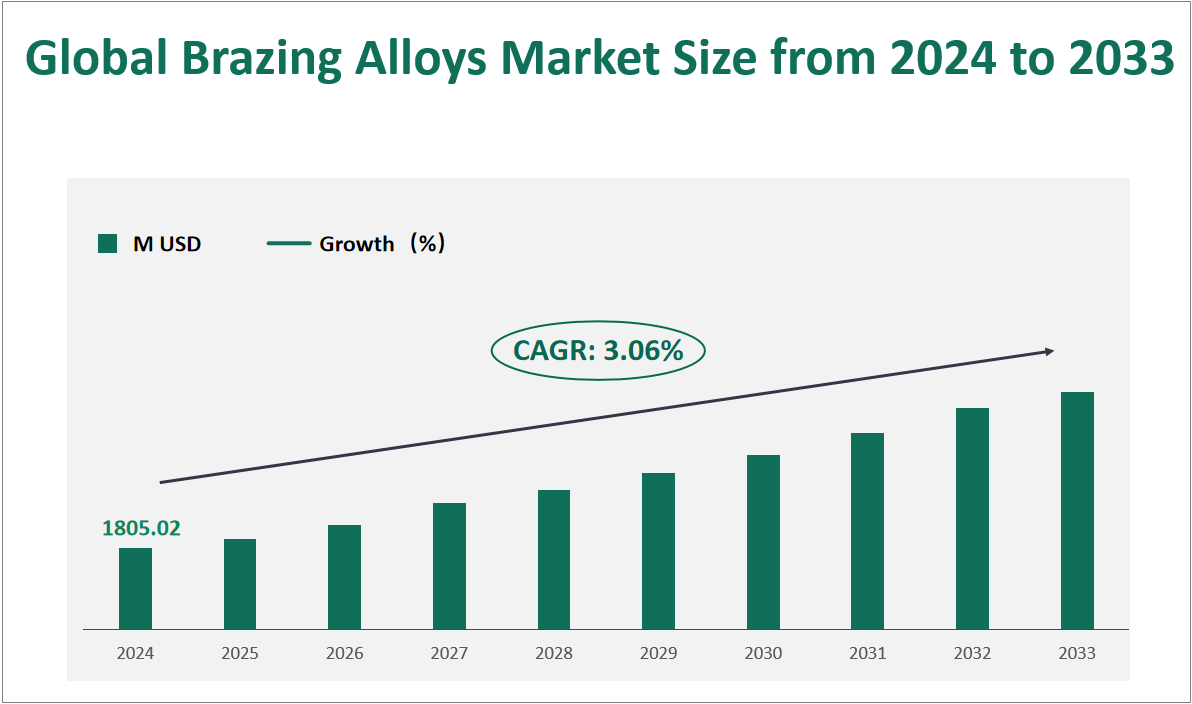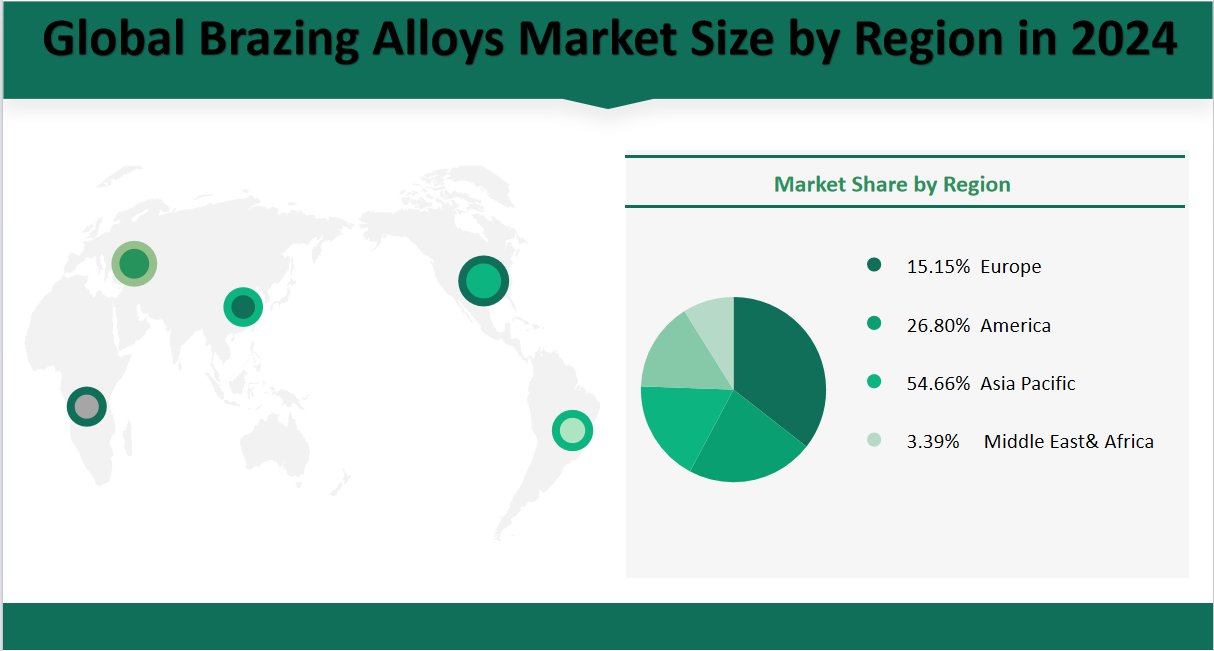1 Global Brazing Alloys Market Outlook
The global Brazing Alloys market is projected to exhibit substantial growth in the coming years, with a CAGR of 3.06% from 2024 to 2033, reaching a total market size of $1805.02 million USD in 2024. Brazing alloys are specialized materials designed to join metal components by melting and flowing into the joint at high temperatures. Unlike soldering, which operates at lower temperatures, brazing typically requires temperatures above 840°F (450°C). These alloys are essential for creating strong, durable joints in applications where precision and reliability are paramount. They are used in a wide range of industries, including automotive manufacturing, where they join engine components; aerospace, where they are crucial for constructing aircraft parts; and electronics, where they ensure the integrity of electrical connections.
Figure Global Brazing Alloys Market Size and Growth Rate (2024-2033)

2 Brazing Alloys Market Growth Drivers and Constraints
The growth of the global Brazing Alloys market is influenced by several key factors. On the positive side, the rapid development of downstream industries such as automotive, aerospace, and electronics is a major driver. These industries require high-quality brazing alloys to ensure the structural integrity and performance of their products. For instance, the increasing demand for lightweight and fuel-efficient vehicles has led to a greater need for brazing alloys in automotive manufacturing. Similarly, the aerospace industry relies heavily on brazing alloys for constructing aircraft components that must withstand extreme conditions.
Another significant driver is the continuous technological innovation in the brazing process. Advances in materials science and manufacturing techniques have led to the development of new and improved brazing alloys with enhanced properties. These innovations have expanded the range of applications for brazing alloys, further boosting market demand. For example, the introduction of low-temperature brazing alloys has made the process more energy-efficient and cost-effective, making it attractive to a broader range of industries.
However, the market also faces several challenges that could limit its growth. One major challenge is the high cost of raw materials, particularly metals like silver and nickel. Fluctuations in the prices of these materials can significantly impact the production costs of brazing alloys, potentially squeezing profit margins. Additionally, the market faces intense competition, with many players vying for market share. This competition often leads to price wars, which can further erode profitability.
The COVID-19 pandemic has also had a significant impact on the Brazing Alloys market. The disruption of supply chains and the decline in industrial production have led to a decrease in demand for brazing alloys. However, as the global economy recovers, the market is expected to rebound, driven by the resumption of industrial activities and the continued growth of downstream industries.
In conclusion, the global Brazing Alloys market is poised for steady growth driven by increasing industrial demand, technological advancements, and strategic corporate moves. However, challenges such as high raw material costs and intense competition must be navigated to ensure sustainable growth. As the market continues to evolve, companies that invest in innovation and strategic partnerships are likely to gain a competitive edge and capture a larger share of the growing market
3 Brazing Alloys Market Innovations and M&A Activities
The Brazing Alloys market is characterized by continuous technological innovation aimed at improving the performance and efficiency of brazing processes. Companies are investing heavily in research and development to create new alloys with enhanced properties such as lower melting points, better corrosion resistance, and higher strength. For example, the development of active brazing alloys has enabled the joining of dissimilar metals without the need for additional flux, simplifying the brazing process and reducing costs.
Corporate mergers and acquisitions have also played a significant role in shaping the market. These strategic moves have allowed companies to expand their product portfolios, enhance their technological capabilities, and strengthen their market positions. For instance, Umicore’s acquisition of Freeport’s cathode precursor business has significantly boosted its presence in the cobalt market, which is crucial for the production of certain brazing alloys. Similarly, Materion’s acquisition of H.C. Starck’s electronic materials portfolio has expanded its access to the high-growth semiconductor market.
In addition to technological innovation and mergers and acquisitions, the market is also influenced by broader industry trends. The increasing adoption of automation and intelligent manufacturing processes is driving the demand for high-quality brazing alloys that can withstand the rigors of modern industrial production. Companies are also focusing on improving their supply chain management to ensure a steady supply of raw materials and mitigate the risks associated with price fluctuations.
4 Global Brazing Alloys Market Analysis by Type
In 2024, the global Brazing Alloys market is projected to consume a total of 118,477 tons. Among the different types, Aluminum Brazing Alloys are expected to dominate with 64,283 tons of consumption, accounting for 54.26% of the total market. Copper Brazing Alloys will follow with 43,886 tons, representing 37.04% of the market. Silver Brazing Alloys are forecasted to have a consumption of 1,817 tons, holding a market share of 1.53%. Nickel Brazing Alloys are expected to see 2,976 tons of consumption, contributing to 2.51% of the market, while Other types will make up 5,515 tons, or 4.65% of the total. This distribution highlights the continued reliance on aluminum and copper alloys due to their versatility and widespread use across various industrial applications.
Table Global Brazing Alloys Consumption and Share by Type in 2024
Type | Consumption in 2024 (Tons) | Market Share in 2024 (%) |
|---|---|---|
Aluminum Brazing Alloys | 64283 | 54.26% |
Copper Brazing Alloys | 43886 | 37.04% |
Silver Brazing Alloys | 1817 | 1.53% |
Nickel Brazing Alloys | 2976 | 2.51% |
Others | 5515 | 4.65% |
5 Global Brazing Alloys Market Analysis by Application
In 2024, the global Brazing Alloys market is forecasted to have a total consumption of 118,477 tons. By application, the market is segmented as follows:
Automotive: This sector is expected to consume 47,196 tons, accounting for 39.84% of the total market. The demand is driven by the need for lightweight and durable components in the automotive industry.
Aerospace: Consumption is projected at 15,832 tons, representing 13.36% of the market. The aerospace industry relies heavily on brazing alloys for their high strength and corrosion resistance.
Electrical Industry: This segment is expected to consume 26,696 tons, making up 22.53% of the market. The growth is attributed to the increasing demand for efficient electrical components.
Household Appliances: Consumption is forecasted to be 20,760 tons, contributing to 17.52% of the total market. The demand is driven by the need for durable and reliable connections in appliances.
Others: Miscellaneous applications, including HVAC and industrial equipment, are expected to account for 7,993 tons, or 6.75% of the market.
These figures highlight the diverse applications of brazing alloys across key industries, driven by their versatility and ability to create strong, reliable joints without melting base materials..
Table Global Brazing Alloys Consumption and Share by Application in 2024
Application | Consumption in 2024 (Tons) | Market Share in 2024 (%) |
|---|---|---|
Automotive | 47196 | 39.84% |
Aerospace | 15832 | 13.36% |
Electrical Industry | 26696 | 22.53% |
Household Appliances | 20760 | 17.52% |
Others | 7993 | 6.75% |
6 Global Brazing Alloys Market Analysis by Region
In 2024, the global Brazing Alloys market is forecasted to have a value of $1805.02 million USD. The market share and value for each region are as follows:
Asia Pacific: This region holds the largest market share at 54.66%, with a value of approximately $986.62 million USD. The growth is driven by the rapid industrialization and urbanization in countries like China and India, as well as significant investments in the automotive and electronics industries.
America: The market share for America is around 26.80%, with a value of $483.75 million USD. The demand is primarily driven by the automotive and aerospace industries.
Europe: Europe accounts for 15.15% of the market share, with a value of $273.40 million USD. The region benefits from its well-established manufacturing base in automotive and electrical industries.
Middle East and Africa: This region holds a market share of 3.44%, with a value of $61.25 million USD. The growth is supported by emerging industrial activities and infrastructure projects.
Figure Global Brazing Alloys Market Share by Region in 2024

7 Top 3 Companies of Global Brazing Alloys Market
7.1 Hangzhou Huaguang
Company Introduction and Business Overview:
Hangzhou Huaguang is a leading enterprise in the field of brazing alloys, specializing in the research, development, and manufacturing of a wide range of brazing materials. Established in 1995, the company is headquartered in China and operates manufacturing facilities in the country. Hangzhou Huaguang is known for its high-quality products and strong technical capabilities, with a focus on innovation and customer satisfaction.
Products Offered:
Hangzhou Huaguang offers a diverse range of brazing alloys, including silver-based, copper-based, and aluminum-based materials. Their products are available in various forms such as rods, wires, strips, foils, powders, and pastes, catering to different industrial applications. These alloys are widely used in HVAC/R, household appliances, electrical machinery, automotive, aerospace, and other sectors.
Sales Revenue in the Latest Year:
In the latest year, Hangzhou Huaguang reported significant sales revenue was 179.69 million USD, driven by its extensive product portfolio and strong market presence. The company’s revenue was bolstered by its commitment to innovation and customer service.
7.2 Harris Products Group
Company Introduction and Business Overview:
Harris Products Group is a world leader in metal working products used in the brazing, soldering, welding, cutting, and gas distribution industries. Founded in 2006, the company operates manufacturing facilities in Mason, Ohio, USA; Gainesville, Georgia, USA; Dzierzonow, Poland; and Sao Paulo, Brazil. Each facility is ISO 9001 certified for quality management systems and ISO 14001 certified for environmental management systems.
Products Offered:
Harris Products Group offers a wide range of brazing and soldering alloys, including flux-cored aluminum brazing alloys like ALUXCOR 78/22, which are ideal for joining aluminum to copper or brass. These alloys are known for their excellent strength, corrosion resistance, and ease of use. The company also provides specialized products for HVAC/R applications, automotive units, and other industrial uses.
Sales Revenue in the Latest Year:
In the latest year, Harris Products Group reported significant sales revenue was 135.54 million USD, driven by its extensive product portfolio and strong market presence. The company’s revenue was bolstered by its commitment to innovation and customer service.
7.3 Lucas-Milhaupt
Company Introduction and Business Overview:
Lucas-Milhaupt is a global manufacturer of brazing and metal joining materials, with a history dating back to 1942. The company is renowned for its high-quality alloys and brazing materials, providing metal joining consultation services and brazing education across North America, Europe, and Asia. Lucas-Milhaupt’s manufacturing facilities are strategically located to serve these regions effectively.
Products Offered:
Lucas-Milhaupt offers a diverse range of brazing alloys, including AL 822, a low-temperature alloy ideal for brazing aluminum to copper. This alloy is particularly popular in HVAC/R applications due to its non-corrosive flux and ease of use. The company also provides a variety of other alloys and brazing materials tailored to specific industrial needs.
Sales Revenue in the Latest Year:
In the latest year, Lucas-Milhaupt reported significant sales revenue was 113.11 million USD, driven by its extensive product portfolio and strong market presence. The company’s revenue was bolstered by its commitment to innovation and customer service.

